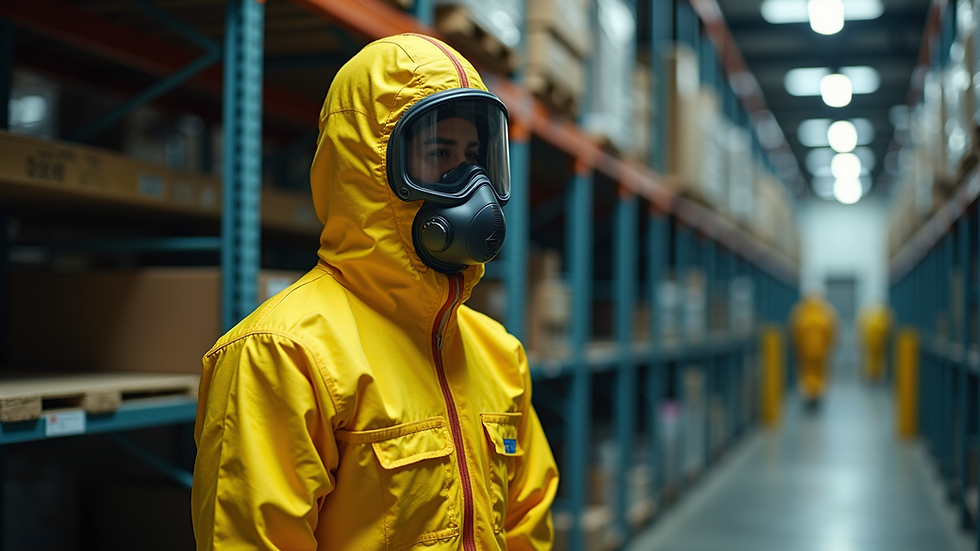Key Safety Measures for Handling Dangerous Goods
- Mads Christiansen

- Jul 22
- 4 min read
Handling dangerous goods is not just a matter of following regulations; it's about protecting lives and the environment. Every year, incidents related to the improper handling of hazardous materials lead to severe consequences, including injuries, fatalities, and environmental damage. Whether you're in a warehouse, a manufacturing facility, or even at a construction site, knowing key safety measures can help mitigate risks and ensure a safer workplace.
Understanding Dangerous Goods
Dangerous goods, also known as hazardous materials, include substances that can cause harm to health, property, or the environment. These materials range from flammable liquids and toxic chemicals to corrosive agents and radioactive materials. The classification of these goods is usually based on their physical and chemical properties, as well as the potential hazards they pose. For instance, materials classified as flammable may ignite easily, while toxic substances can lead to illness if ingested or inhaled.

To effectively manage dangerous goods, employers must understand the various types of hazards associated with these materials. According to the National Fire Protection Association, there are over 1,000 types of dangerous goods that fall into different categories based on their risks. This includes gases, liquids, solids, and biohazards.
Safety Measures for Dangerous Goods
When dealing with dangerous goods, implementing strong safety measures is essential. Here are some key practices that should be adhered to:
1. Proper Training
Training employees thoroughly on the risks associated with dangerous goods is crucial. All personnel who handle these materials must be knowledgeable about their properties and the specific safety measures that need to be taken. Companies should provide regular training sessions and refreshers to keep safety at the forefront of their operations.
2. Use of Personal Protective Equipment (PPE)
Personal protective equipment is vital when handling hazardous materials. This can include gloves, goggles, respirators, and specialized clothing. Each job will require a different type of PPE, so it is essential to evaluate the specific risks involved with each dangerous good and ensure that workers are properly equipped.

3. Emergency Response Planning
Being prepared for emergencies can save lives and minimize damage. Develop an emergency response plan that outlines what to do in case of a spill, leak, or any other incident involving dangerous goods. Conduct drills regularly so that all staff know their roles and responsibilities.
4. Proper Storage and Labeling
Dangerous goods must be stored correctly to prevent accidents. Use compatible materials for storage and follow guidelines for temperature control and ventilation. It’s also essential to label all containers clearly. Labels should contain information about the contents, hazards involved, and instructions for safe handling.
5. Regular Inspections
Regular inspections of storage areas, equipment, and handling procedures are necessary. Companies should maintain a schedule for inspecting areas where dangerous goods are stored and ensure that all safety measures are up to date. This includes checking for any signs of wear or damage to PPE and storage containers.

What are the Safety Handling of Dangerous Goods?
Handling dangerous goods safely involves a comprehensive approach that includes compliance with local laws and regulations as well as internal safety policies. OSHA, or the Occupational Safety and Health Administration, provides guidelines on the proper handling, packaging, and transportation of hazardous materials. Familiarize yourself with these rules to ensure compliance and safety in your operations.
Safety handling requires clear communication among all employees involved in the process. Companies should encourage a culture of safety where employees feel empowered to voice concerns about unsafe practices or conditions. Regular meetings, safety audits, and open lines of communication help reinforce this culture.
1. Transportation Considerations
Transportation of dangerous goods is particularly risky and must be carried out with the utmost concern for safety. Ensure that all vehicles used for transporting hazardous materials are well-maintained and meet compliance standards. Only trained and qualified personnel should handle the loading and unloading processes. Furthermore, it is crucial to choose the right packaging to prevent leaks or spills during transportation.
2. Disposal of Hazardous Waste
Proper disposal of hazardous waste is just as important as safe handling. Many dangerous goods require special treatment for disposal. Follow local regulations and guidelines to ensure that waste is disposed of safely and responsibly. Engaging a licensed hazardous waste disposal company can help mitigate liability and ensure compliance with state and federal laws.
3. Incident Reporting
Establish a clear protocol for reporting incidents related to dangerous goods. Encourage employees to document any incidents or near-misses to improve safety practices continuously. Use this data to analyze trends and make necessary adjustments to policies and practices.
Building a Safety Culture
Creating a workplace culture that emphasizes safety can significantly reduce the risks associated with handling dangerous goods. A positive safety culture promotes awareness and adherence to safety practices among employees and management alike. Here are ways to develop such a culture:
1. Leadership Commitment
Leadership plays a crucial role in promoting safety. When management prioritizes safety and actively participates in safety training and discussions, it sets a standard for all employees. Visible commitment from leadership can motivate employees to take safety seriously.
2. Employee Involvement
Engage employees in safety committees and decision-making processes regarding safety protocols. This fosters a sense of ownership and accountability for safety practices among staff. Regular feedback from employees can lead to improvements in safety procedures.
3. Recognition and Incentives
Introduce recognition programs for employees who demonstrate exemplary safety behavior. Celebrating achievements, such as milestone safety records, can motivate others to follow suit and prioritize safe practices in their daily routines.
In summary, effective safety measures for handling dangerous goods require a combination of proper training, the use of PPE, and adherence to regulations and best practices. Employers must not only implement these measures but also foster a culture of safety throughout the organization. For more detailed information on these practices, check out the resource on dangerous goods handling.
In addressing the challenges posed by dangerous goods, it is essential to remain vigilant and proactive. The risk of accidents may never be completely eliminated, but through careful planning, proper training, and adherence to safety protocols, the potential for harm can be minimized significantly. Always remember that safety is a shared responsibility and requires the commitment of everyone involved.




.png)